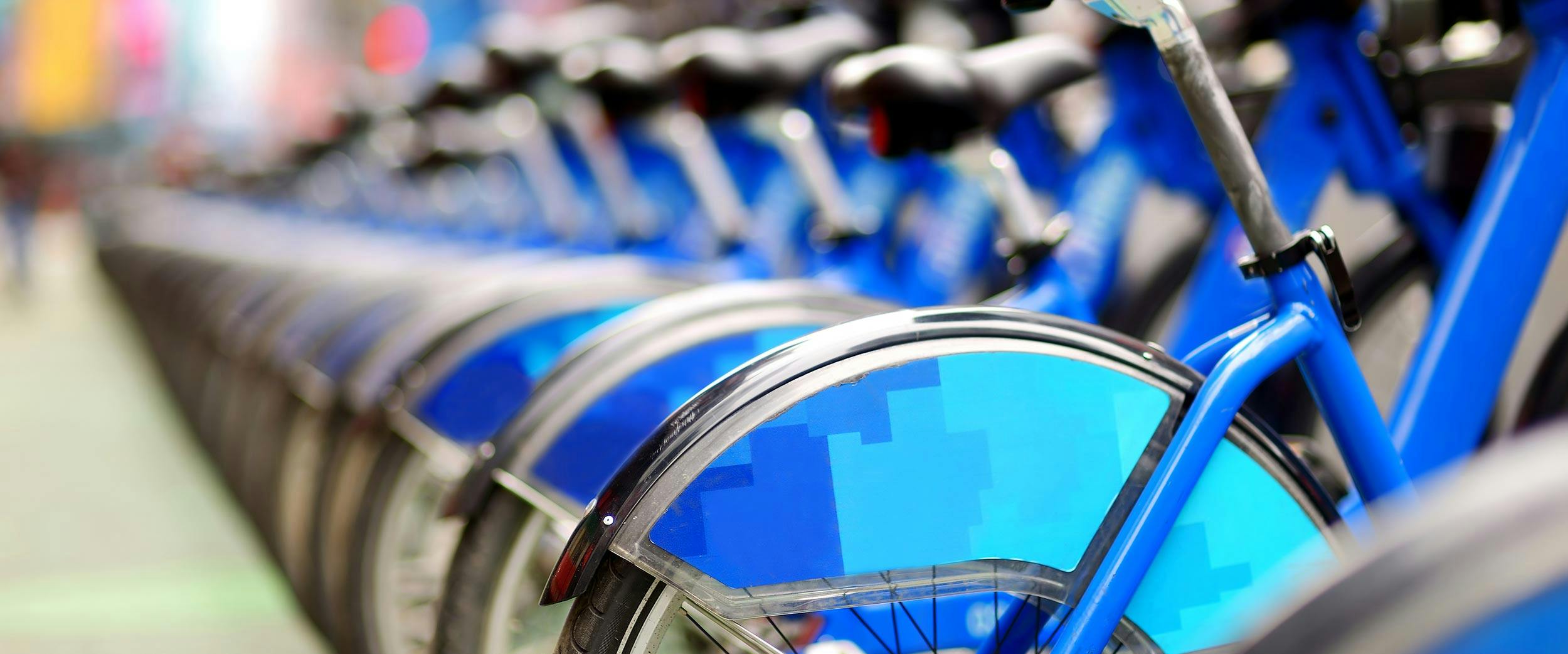
If you're a landlord with properties in a city, chances are you've seen branded bicycles in large parking stations on major streets or dockless bicycles/scooters left on the sidewalks that say something like "download this app, pay, and start riding."
In 2017, riders made 35 million bike share trips and the number of bike share bikes has more than doubled from 42,500 bikes at the end of 2016 to about 100,000 bikes by the end of 2017. With these numbers on track to continue growing, this is a trend urban landlords can't ignore.
Whether you see them as a nuisance or a service with value, we believe bike sharing programs are here to stay. Here's what you need to know about the challenges bike shares might pose for you and how you can use them to your advantage.
What are Bike Share Programs?
Bike share programs offer an alternate way for city dwellers to get around for a low cost. For those who don't own a bicycle but enjoy the convenience of inexpensive, on-demand, direct travel, bike shares are a good solution.
Rides can be purchased via a mobile app or kiosk, and usually can be bought two ways: pay-in-advance flat-charge memberships/short-term passes OR pay-when-done usage fees for time spent riding. Long term memberships (annual, monthly) and short term passes (daily, weekly) are good for unlimited rides within a specific period of time and must be purchased before riding. Usage fees for time spent riding are good for one-off rides and are usually calculated in increments.
These systems allow for point-to-point travel (rather than a bike rental from a shop), which means people can use the bikes as a legitimate transportation method for needs like commuting, running errands, or visiting friends, rather than simply recreation. However, it's important to note bikes are limited to specific geographical boundaries.
#1: Station Bike Shares
Stations are basically high-tech bike racks that store multiple bikes and lock them when they're not in use. This kind of system is currently most common in the US, often implemented by municipalities. Bikes in this program are difficult to mistake for regular bikes because they're usually bulkier with robust high-set frames that don't look like road or mountain bikes, bright colors, and a large branded logo.

To pay for a ride, people can insert a credit card or enter a code through an app (after creating a personal login). Payment unlocks the bike and voila, you're ready to ride. After you're done riding, you have to return the bike to another station in the network, provided there's an available docking space. Many cities have a "branded" station bike share program within their limits.
#2: Dockless Bike & Scooter Sharing Programs
Companies like Jump, Lime, and Bird offer dockless bikes, electric bikes, scooters, and electric scooters that you can ride on demand and leave wherever you like. Normally regarded as more user-friendly programs, these are the kinds of bikes and scooters you might find left at random on the sidewalk. Riders can stumble upon one, use the app to pay for the ride and unlock it, hop on, and then park it in another spot.

These programs can be found in many different cities across the country, and you can use the same app if you were to ride a Jump bike in Providence, RI and then another in Austin, TX. However, these programs are only good for single-ride options, rather than flat-fee memberships.
Dockless scooters and bicycles have become rather controversial in some places. The tech companies behind the bikes have raised hefty amounts of funding, which allows them to simply scatter their products around cities and offer them straight to consumers. According to the New York Times, cities are shocked that thousands of scooters have been dropped on their sidewalks and that the companies have ignored getting city approvals to set them up. Additionally, "Since the scooters are dockless, riders can just grab one, go a few blocks and leave it wherever they want, causing a commotion on sidewalks and scenes of scooters strewn across wheelchair ramps and in doorways." Some cities have even threatened these companies against bringing the scooters to their municipalities.

Handling Bike Shares Near Your Property
You are not liable for your tenants riding these bikes. However, we do recommend you to encourage them to ride with helmets.
By design, station bikes cannot be taken onto your property. As to not incur additional fees, riders must leave them at a dock. Dockless bikes and scooters may end up on your property, though, because they can be left wherever. Simply inform your residents that bike shares are not to be brought onto the property. You can have them sign an official document, or make a lease addendum to ensure they will abide by the rule. Before making any agreements though, consult with your lawyer.
Depending on if your unit is very close to a bike station, you might experience a bit more foot traffic by the entry than usual. If this is a concern for you and your residents' safety, consider installing security cameras. Increased activity around the property can also mean more eyes on packages left outside of the building's doorway. You might also want to consider ways to protect residents' deliveries from becoming easy targets of potential theft.
Using Bike Shares to Your Advantage
Proximity to bike shares can be very attractive to prospective renters who are interested in living more active or eco-friendly lifestyles. Additionally, if your rental does not have a fitness center or bike room, this is a great alternate physical and transportation benefit to promote. When writing your rental description, be sure to call out the unit's proximity to this amenity.
According to Wired, "[Lime] has seen demand from landlords. A number of commercial and residential real estate owners have become interested in bike sharing as a way to make their properties more valuable, says Brad Greiwe, a managing partner at Fifth Wall Ventures, which focuses on real estate...Greiwe says property owners are eager to adopt dockless bike sharing because it can expand accessibility to buildings, especially ones that aren't within walking distance to public transit. Further, tenants increasingly expect bike sharing as an amenity, he says, and landlords want to partner to provide hubs and storage areas for bikes."
You can also use bike membership as a small gesture to show tenant appreciation, increase lease renewals, and fill vacant units as a way to sweeten the deal. Retaining and attracting quality renters can be worth the small cost.
Understand Your Renters
As a landlord, it's important to know the lifestyle changes that are happening in the lives of your ideal renter demographic. Transportation access, physical activity, and eco-friendly alternatives are becoming increasingly important to city dwellers. You have the opportunity to adapt to and accommodate these trends to remain competitive to your desired renter base.
Consider working with a property management company to help you navigate these changes and understand what your renters want. They can also help you write fantastic rental descriptions, communicate with tenants, survey the property and make lease amendments. Ready to start searching? Request quotes from property managers in your area—for free.
City-Based Station Bike Sharing Programs in the United States
To see if there's a station bike sharing program in the urban area where your properties are, we compiled an alphabetical list by city. Please note this information may change as the programs grow and evolve. For the dockless options of Jump, Lime, and Bird, visit their websites to see if they're available in your metro area.
- Aspen/Basalt, CO: WE-cycle
- Albany, NY: CDPHP Cycle
- Alpharetta, GA: Zagster
- Atlanta, GA: Relay Bike Share
- Austin, TX: Austin B-cycle
- Birmingham, AL: Zyp BikeShare
- Boston/Brookline/Cambridge/Somerville, MA: Bluebikes
- Boulder, CO: Boulder B-cycle
- Broward County, FL: Broward BCycle
- Buffalo, NY: Reddy Bikeshare
- Charleston, SC: Holy Spokes
- Charlotte, NC: Charlotte B-Cycle
- Chattanooga, TN: Bike Chattanooga
- Chicago, IL: Divvy
- Cincinnati, OH: Cincinnati Red Bike
- Cleveland, OH: UH Bikes
- Columbus, OH: CoGo Bike Share
- Dever, CO: Denver B-cycle
- Des Moines, IA: Des Moines BCycle
- Detroit, MI: MoGo
- Eugene, OR: PeaceHealth Rides
- Fargo, ND: Great Rides Bike Share
- Fort Worth, TX: Fort Worth BCycle
- Greenville, NC: Greenville BCycle
- Honolulu, HI: Biki
- Houston, TX: Houston BCycle
- Indianapolis, IN: Pacers Bikeshare
- Jersey City, NJ: Citi Bike
- Kansas City, MO: RideKC Bike
- Los Angeles, CA: Metro Bike Share
- Madison, WI: Madison BCycle
- Manhattan, KS: Green Apple Bikes
- Memphis, TN: Explore Bike Share
- Miami & Miami Beach, FL: Citi Bike Miami
- Milwaukee, WI: Bublr Bikes
- Minneapolis, MN: Nice Ride Minnesota
- New Orleans, LA: Blue Bikes
- New York City, NY: Citi Bike
- Oklahoma City, OK: Spokies
- Philadelphia, PA: Indego
- Phoenix/Mesa/Temple, AZ: Grid Bike Share
- Pittsburgh, PA: Healthy Ride
- Portland, OR: BIKETOWN
- Salem, MA: Zagster
- Salt Lake City, UT: GREENBike
- San Francisco/Bay Area, CA: Ford GoBike
- Topeka, KS: Topeka Metro Bikes
- Tucson, AZ: Tugo Bike Share
- Tulsa, OK: This Machine
- Washington, D.C. & Northern VA: Capital Bikeshare
